brakes HYUNDAI TUCSON LIMITED 2017 Owner's Guide
[x] Cancel search | Manufacturer: HYUNDAI, Model Year: 2017, Model line: TUCSON LIMITED, Model: HYUNDAI TUCSON LIMITED 2017Pages: 642, PDF Size: 9.78 MB
Page 492 of 642
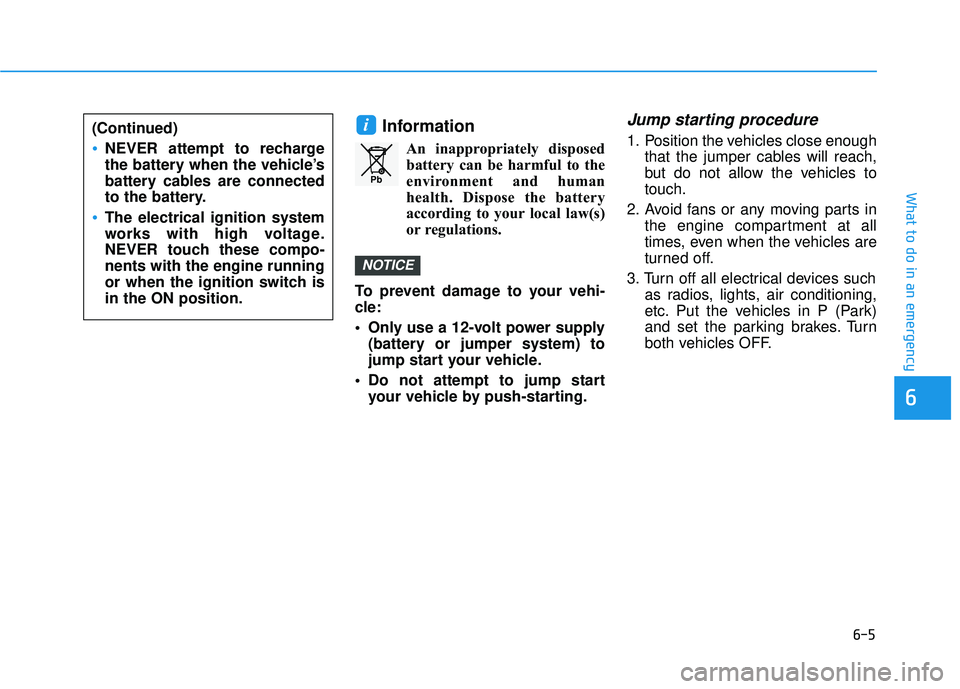
6-5
What to do in an emergency
6
Information
An inappropriately disposedbattery can be harmful to the
environment and human
health. Dispose the battery
according to your local law(s)
or regulations.
To prevent damage to your vehi-
cle:
Only use a 12-volt power supply (battery or jumper system) to
jump start your vehicle.
Do not attempt to jump start your vehicle by push-starting.
Jump starting procedure
1. Position the vehicles close enough that the jumper cables will reach,
but do not allow the vehicles totouch.
2. Avoid fans or any moving parts in the engine compartment at all
times, even when the vehicles are
turned off.
3. Turn off all electrical devices such as radios, lights, air conditioning,
etc. Put the vehicles in P (Park)
and set the parking brakes. Turn
both vehicles OFF.
NOTICE
i
Pb
(Continued)
NEVER attempt to recharge
the battery when the vehicle’s
battery cables are connected
to the battery.
The electrical ignition system
works with high voltage.
NEVER touch these compo-nents with the engine running
or when the ignition switch isin the ON position.
Page 501 of 642
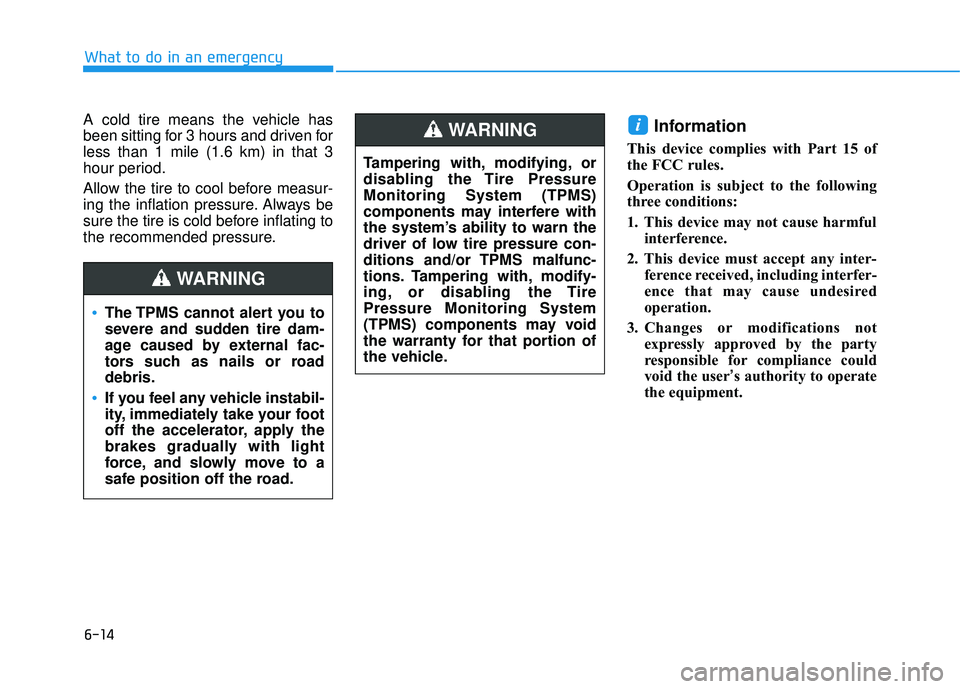
6-14
What to do in an emergency
A cold tire means the vehicle has
been sitting for 3 hours and driven forless than 1 mile (1.6 km) in that 3
hour period.
Allow the tire to cool before measur-
ing the inflation pressure. Always be
sure the tire is cold before inflating to
the recommended pressure.Information
This device complies with Part 15 of
the FCC rules.
Operation is subject to the following
three conditions:
1. This device may not cause harmfulinterference.
2. This device must accept any inter- ference received, including interfer-
ence that may cause undesired
operation.
3. Changes or modifications not expressly approved by the party
responsible for compliance could
void the user ’s authority to operate
the equipment.
i
The TPMS cannot alert you to
severe and sudden tire dam-
age caused by external fac-
tors such as nails or roaddebris.
If you feel any vehicle instabil-
ity, immediately take your foot
off the accelerator, apply the
brakes gradually with light
force, and slowly move to a
safe position off the road.
WARNING
Tampering with, modifying, or
disabling the Tire PressureMonitoring System (TPMS)
components may interfere with
the system’s ability to warn the
driver of low tire pressure con-
ditions and/or TPMS malfunc-
tions. Tampering with, modify-
ing, or disabling the TirePressure Monitoring System
(TPMS) components may void
the warranty for that portion of
the vehicle.
WARNING
Page 512 of 642
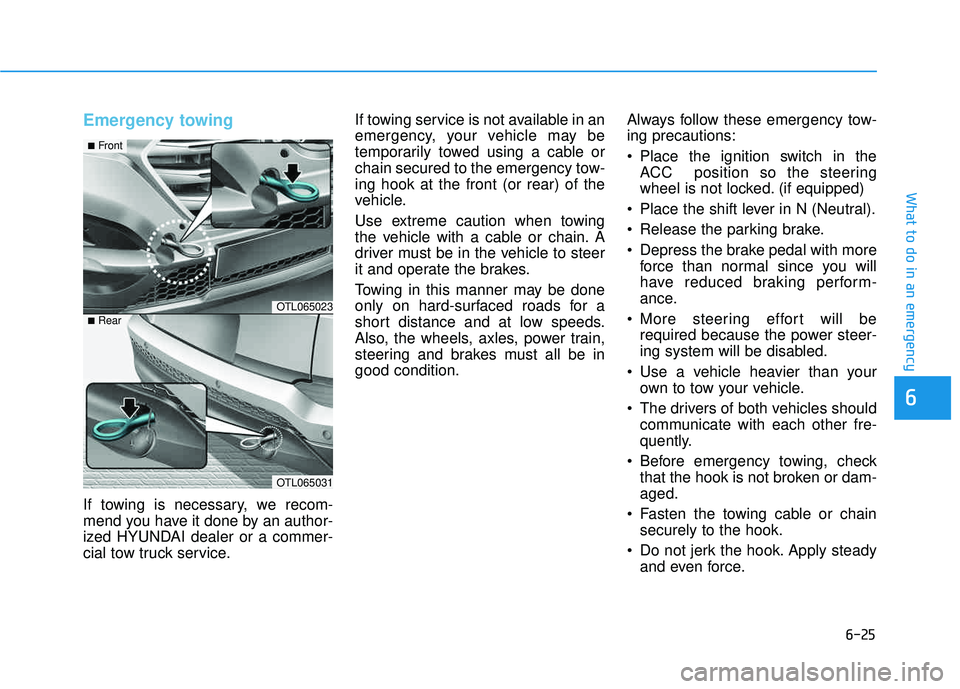
6-25
What to do in an emergency
Emergency towing
If towing is necessary, we recom-
mend you have it done by an author-
ized HYUNDAI dealer or a commer-
cial tow truck service.If towing service is not available in an
emergency, your vehicle may be
temporarily towed using a cable or
chain secured to the emergency tow-ing hook at the front (or rear) of the
vehicle.
Use extreme caution when towing
the vehicle with a cable or chain. A
driver must be in the vehicle to steer
it and operate the brakes.
Towing in this manner may be done
only on hard-surfaced roads for a
short distance and at low speeds.
Also, the wheels, axles, power train,
steering and brakes must all be ingood condition.
Always follow these emergency tow-ing precautions:
Place the ignition switch in the
ACC position so the steering
wheel is not locked. (if equipped)
Place the shift lever in N (Neutral).
Release the parking brake.
Depress the brake pedal with more force than normal since you will
have reduced braking perform-
ance.
More steering effort will be required because the power steer-
ing system will be disabled.
Use a vehicle heavier than your own to tow your vehicle.
The drivers of both vehicles should communicate with each other fre-
quently.
Before emergency towing, check that the hook is not broken or dam-aged.
Fasten the towing cable or chain securely to the hook.
Do not jerk the hook. Apply steady and even force.
6
OTL065023
OTL065031
■Front
■Rear
Page 521 of 642
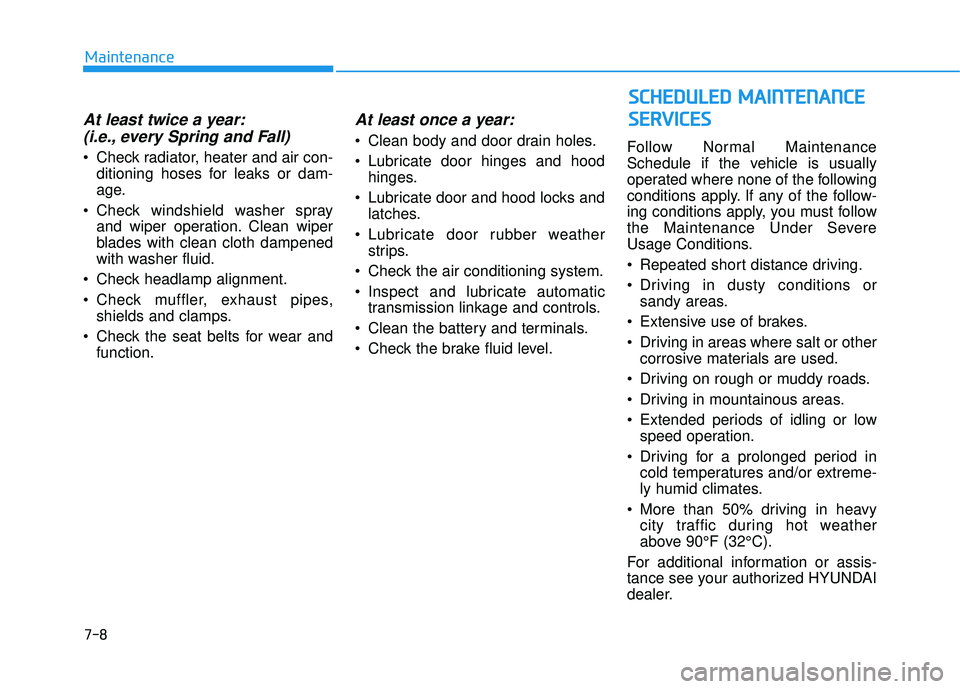
7-8
Maintenance
At least twice a year:(i.e., every Spring and Fall)
Check radiator, heater and air con- ditioning hoses for leaks or dam-
age.
Check windshield washer spray and wiper operation. Clean wiper
blades with clean cloth dampened
with washer fluid.
Check headlamp alignment.
Check muffler, exhaust pipes, shields and clamps.
Check the seat belts for wear and function.
At least once a year:
Clean body and door drain holes.
Lubricate door hinges and hoodhinges.
Lubricate door and hood locks and latches.
Lubricate door rubber weather strips.
Check the air conditioning system.
Inspect and lubricate automatic transmission linkage and controls.
Clean the battery and terminals.
Check the brake fluid level. Follow Normal Maintenance
Schedule if the vehicle is usually
operated where none of the following
conditions apply. If any of the follow-
ing conditions apply, you must follow
the Maintenance Under Severe
Usage Conditions.
Repeated short distance driving.
Driving in dusty conditions or
sandy areas.
Extensive use of brakes.
Driving in areas where salt or other corrosive materials are used.
Driving on rough or muddy roads.
Driving in mountainous areas.
Extended periods of idling or low speed operation.
Driving for a prolonged period in cold temperatures and/or extreme-
ly humid climates.
More than 50% driving in heavy city traffic during hot weather
above 90°F (32°C).
For additional information or assis-
tance see your authorized HYUNDAI
dealer.
SS CC HH EEDD UU LLEE DD MM AAIINN TTEENN AANN CCEE
S
S EE RR VV IICC EE SS
Page 607 of 642
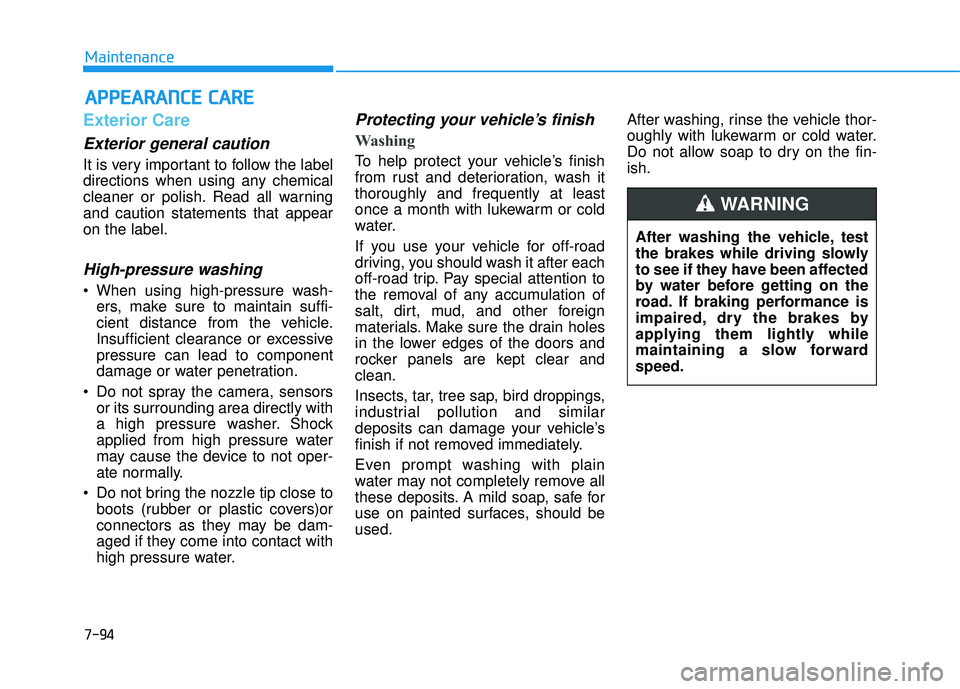
7-94
Maintenance
AAPPPPEEAA RRAA NN CCEE CC AA RREE
Exterior Care
Exterior general caution
It is very important to follow the label
directions when using any chemical
cleaner or polish. Read all warningand caution statements that appearon the label.
High-pressure washing
When using high-pressure wash-
ers, make sure to maintain suffi-
cient distance from the vehicle.
Insufficient clearance or excessivepressure can lead to component
damage or water penetration.
Do not spray the camera, sensors or its surrounding area directly with
a high pressure washer. Shock
applied from high pressure water
may cause the device to not oper-
ate normally.
Do not bring the nozzle tip close to boots (rubber or plastic covers)or
connectors as they may be dam-
aged if they come into contact with
high pressure water.
Protecting your vehicle’s finish
Washing
To help protect your vehicle’s finish
from rust and deterioration, wash itthoroughly and frequently at least
once a month with lukewarm or cold
water.
If you use your vehicle for off-road
driving, you should wash it after each
off-road trip. Pay special attention to
the removal of any accumulation of
salt, dirt, mud, and other foreign
materials. Make sure the drain holes
in the lower edges of the doors and
rocker panels are kept clear andclean.
Insects, tar, tree sap, bird droppings,
industrial pollution and similar
deposits can damage your vehicle’s
finish if not removed immediately.
Even prompt washing with plain
water may not completely remove all
these deposits. A mild soap, safe for
use on painted surfaces, should beused. After washing, rinse the vehicle thor-
oughly with lukewarm or cold water.
Do not allow soap to dry on the fin-ish.
After washing the vehicle, test
the brakes while driving slowly
to see if they have been affected
by water before getting on the
road. If braking performance is
impaired, dry the brakes by
applying them lightly while
maintaining a slow forwardspeed.
WARNING
Page 610 of 642
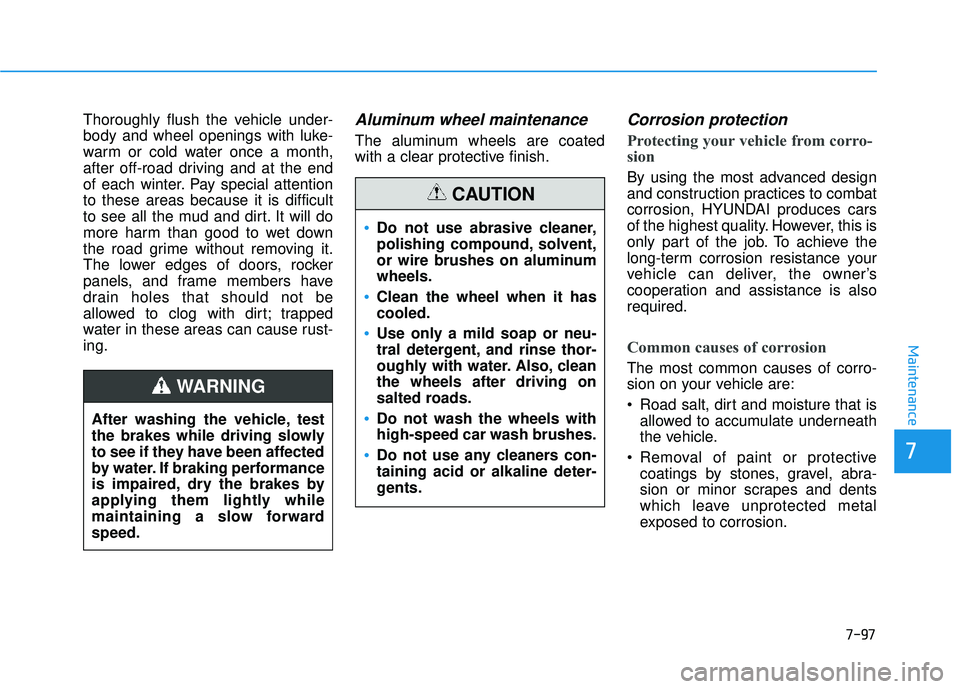
7-97
7
Maintenance
Thoroughly flush the vehicle under-
body and wheel openings with luke-
warm or cold water once a month,
after off-road driving and at the end
of each winter. Pay special attentionto these areas because it is difficult
to see all the mud and dirt. It will do
more harm than good to wet down
the road grime without removing it.
The lower edges of doors, rocker
panels, and frame members have
drain holes that should not be
allowed to clog with dirt; trapped
water in these areas can cause rust-ing.Aluminum wheel maintenance
The aluminum wheels are coated
with a clear protective finish.
Corrosion protection
Protecting your vehicle from corro-
sion
By using the most advanced design
and construction practices to combat
corrosion, HYUNDAI produces cars
of the highest quality. However, this is
only part of the job. To achieve the
long-term corrosion resistance your
vehicle can deliver, the owner’s
cooperation and assistance is alsorequired.
Common causes of corrosion
The most common causes of corro-
sion on your vehicle are:
Road salt, dirt and moisture that isallowed to accumulate underneath
the vehicle.
coatings by stones, gravel, abra-
sion or minor scrapes and dents
which leave unprotected metal
exposed to corrosion.
After washing the vehicle, test
the brakes while driving slowly
to see if they have been affected
by water. If braking performance
is impaired, dry the brakes by
applying them lightly while
maintaining a slow forwardspeed.
WARNING
Do not use abrasive cleaner,
polishing compound, solvent,
or wire brushes on aluminumwheels.
Clean the wheel when it has cooled.
Use only a mild soap or neu-
tral detergent, and rinse thor-
oughly with water. Also, cleanthe wheels after driving on
salted roads.
Do not wash the wheels with high-speed car wash brushes.
Do not use any cleaners con- taining acid or alkaline deter-
gents.
CAUTION
Page 633 of 642
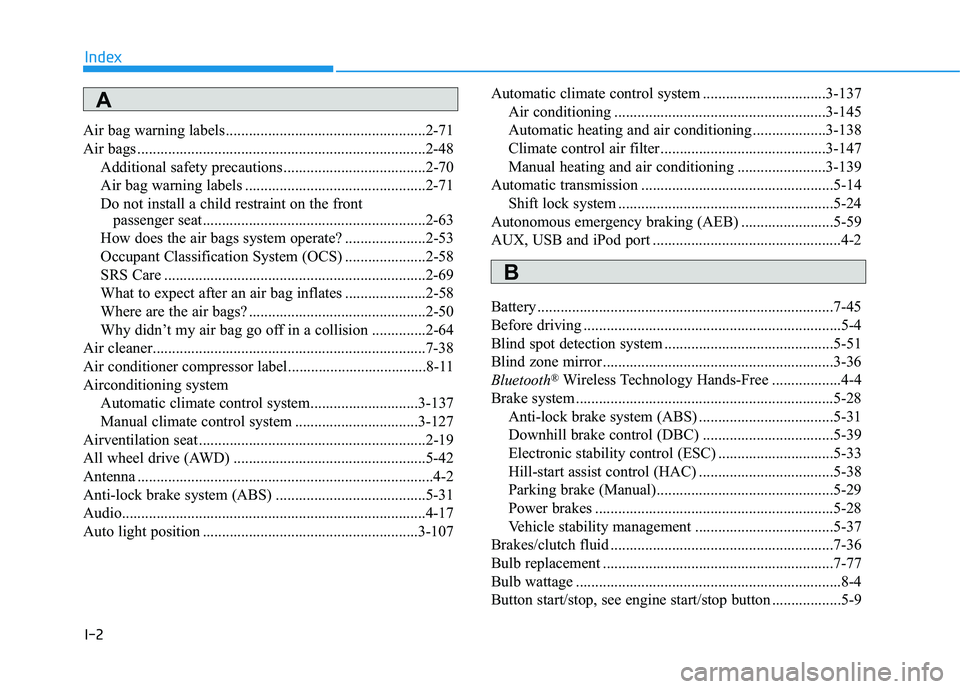
I-2
Air bag warning labels....................................................2-71
Air bags ...........................................................................2-48Additional safety precautions .....................................2-70
Air bag warning labels ...............................................2-71
Do not install a child restraint on the front passenger seat..........................................................2-63
How does the air bags system operate? .....................2-53
Occupant Classification System (OCS) .....................2-58
SRS Care ....................................................................2-69
What to expect after an air bag inflates .....................2-58
Where are the air bags? ..............................................2-50
Why didn’t my air bag go off in a collision ..............2-64
Air cleaner.......................................................................7-38
Air conditioner compressor label....................................8-11
Airconditioning system Automatic climate control system............................3-137
Manual climate control system ................................3-127
Airventilation seat ...........................................................2-19
All wheel drive (AWD) ..................................................5-42
Antenna .............................................................................4-2
Anti-lock brake system (ABS) .......................................5-31
Audio...............................................................................4-17
Auto light position ........................................................3-107 Automatic climate control system ................................3-137
Air conditioning .......................................................3-145
Automatic heating and air conditioning ...................3-138
Climate control air filter ...........................................3-147
Manual heating and air conditioning .......................3-139
Automatic transmission ..................................................5-14 Shift lock system ........................................................5-24
Autonomous emergency braking (AEB) ........................5-59
AUX, USB and iPod port .................................................4-2
Battery .............................................................................7-45
Before driving ...................................................................5-4
Blind spot detection system ............................................5-51
Blind zone mirror............................................................3-36
Bluetooth
®Wireless Technology Hands-Free ..................4-4
Brake system ...................................................................5-28 Anti-lock brake system (ABS) ...................................5-31
Downhill brake control (DBC) ..................................5-39
Electronic stability control (ESC) ..............................5-33
Hill-start assist control (HAC) ...................................5-38
Parking brake (Manual)..............................................5-29
Power brakes ..............................................................5-28
Vehicle stability management ....................................5-37
Brakes/clutch fluid ..........................................................7-36
Bulb replacement ............................................................7-77
Bulb wattage .....................................................................8-4
Button start/stop, see engine start/stop button ..................5-9
Index
A
B
Page 635 of 642
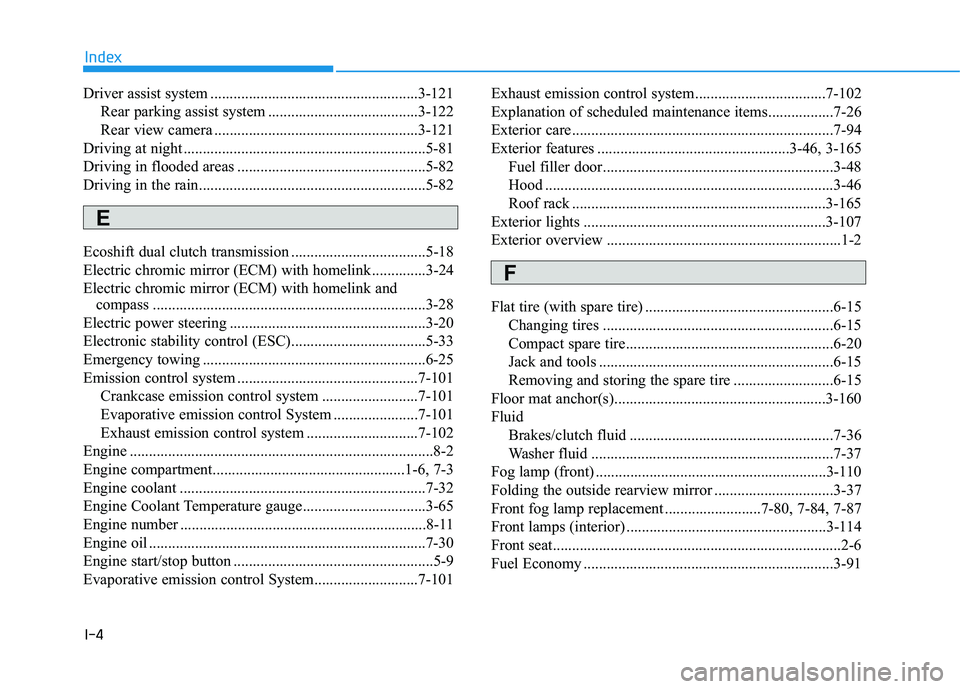
I-4
Driver assist system ......................................................3-121Rear parking assist system .......................................3-122
Rear view camera .....................................................3-121
Driving at night ...............................................................5-81
Driving in flooded areas .................................................5-82
Driving in the rain...........................................................5-82
Ecoshift dual clutch transmission ...................................5-18
Electric chromic mirror (ECM) with homelink ..............3-24
Electric chromic mirror (ECM) with homelink and compass .......................................................................3-28
Electric power steering ...................................................3-20
Electronic stability control (ESC)...................................5-33
Emergency towing ..........................................................6-25
Emission control system ...............................................7-101
Crankcase emission control system .........................7-101
Evaporative emission control System ......................7-101
Exhaust emission control system .............................7-102
Engine ...............................................................................8-2
Engine compartment..................................................1-6, 7-3
Engine coolant ................................................................7-32
Engine Coolant Temperature gauge................................3-65
Engine number ................................................................8-11
Engine oil ........................................................................7-30
Engine start/stop button ....................................................5-9
Evaporative emission control System...........................7-101 Exhaust emission control system..................................7-102
Explanation of scheduled maintenance items.................7-26
Exterior care....................................................................7-94
Exterior features ..................................................3-46, 3-165
Fuel filler door............................................................3-48
Hood ...........................................................................3-46
Roof rack ..................................................................3-165
Exterior lights ...............................................................3-107
Exterior overview .............................................................1-2
Flat tire (with spare tire) .................................................6-15 Changing tires ............................................................6-15
Compact spare tire......................................................6-20
Jack and tools .............................................................6-15
Removing and storing the spare tire ..........................6-15
Floor mat anchor(s).......................................................3-160
Fluid
Brakes/clutch fluid .....................................................7-36
Washer fluid ...............................................................7-37
Fog lamp (front) ............................................................3-110
Folding the outside rearview mirror ...............................3-37
Front fog lamp replacement .........................7-80, 7-84, 7-87
Front lamps (interior) ....................................................3-114
Front seat...........................................................................2-6
Fuel Economy .................................................................3-91
Index
E
F
Page 639 of 642
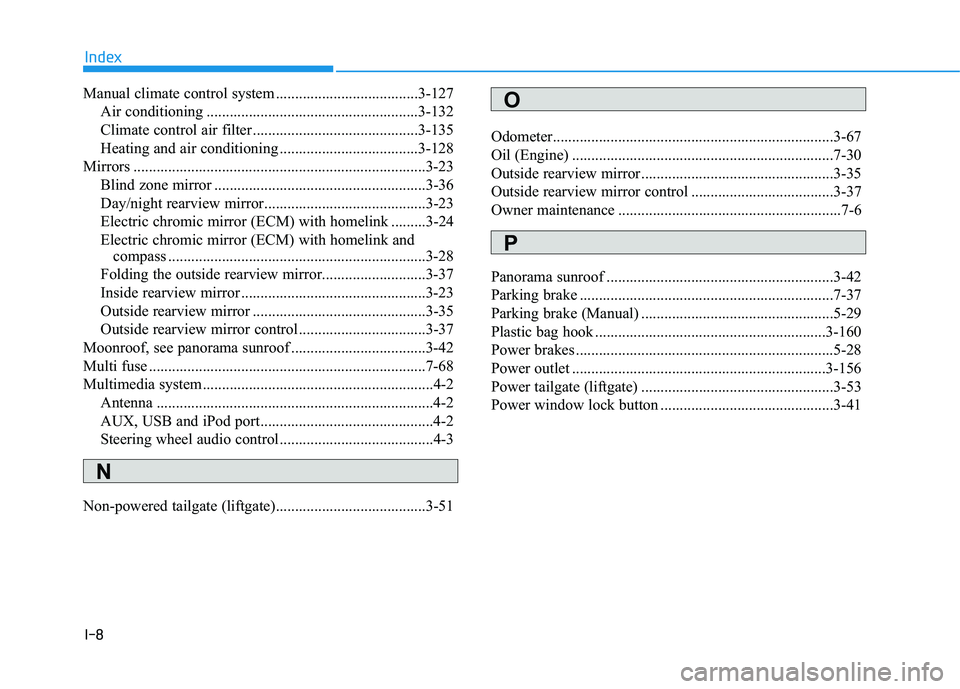
I-8
Manual climate control system .....................................3-127Air conditioning .......................................................3-132
Climate control air filter ...........................................3-135
Heating and air conditioning ....................................3-128
Mirrors ............................................................................3-23 Blind zone mirror .......................................................3-36
Day/night rearview mirror..........................................3-23
Electric chromic mirror (ECM) with homelink .........3-24
Electric chromic mirror (ECM) with homelink and compass ...................................................................3-28
Folding the outside rearview mirror...........................3-37
Inside rearview mirror ................................................3-23
Outside rearview mirror .............................................3-35
Outside rearview mirror control .................................3-37
Moonroof, see panorama sunroof ...................................3-42
Multi fuse ........................................................................7-68
Multimedia system............................................................4-2 Antenna ........................................................................4-2
AUX, USB and iPod port.............................................4-2
Steering wheel audio control........................................4-3
Non-powered tailgate (liftgate).......................................3-51 Odometer.........................................................................3-67
Oil (Engine) ....................................................................7-30
Outside rearview mirror..................................................3-35
Outside rearview mirror control .....................................3-37
Owner maintenance ..........................................................7-6
Panorama sunroof ...........................................................3-42
Parking brake ..................................................................7-37
Parking brake (Manual) ..................................................5-29
Plastic bag hook ............................................................3-160
Power brakes ...................................................................5-28
Power outlet ..................................................................3-156
Power tailgate (liftgate) ..................................................3-53
Power window lock button .............................................3-41
Index
O
P
N